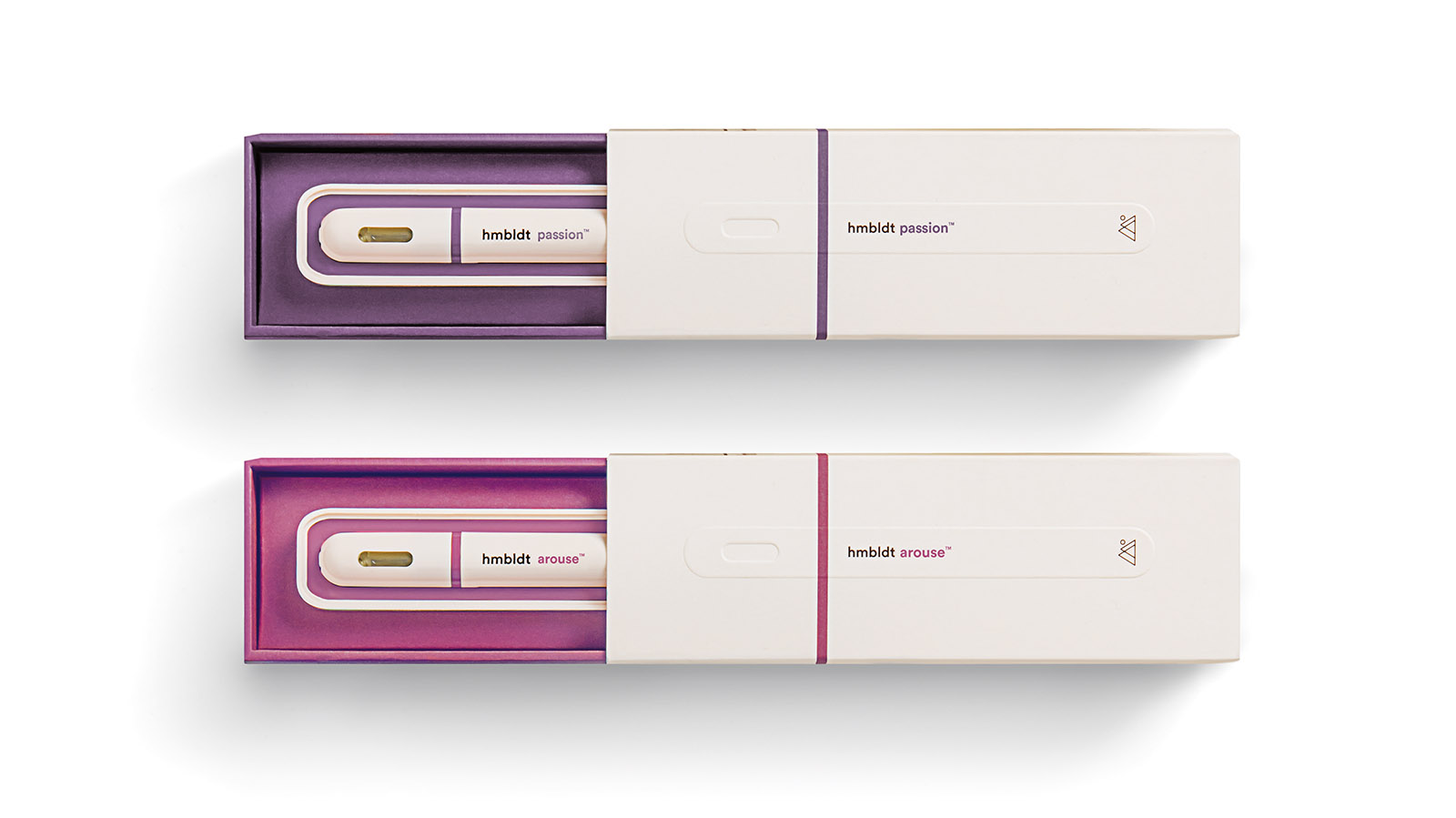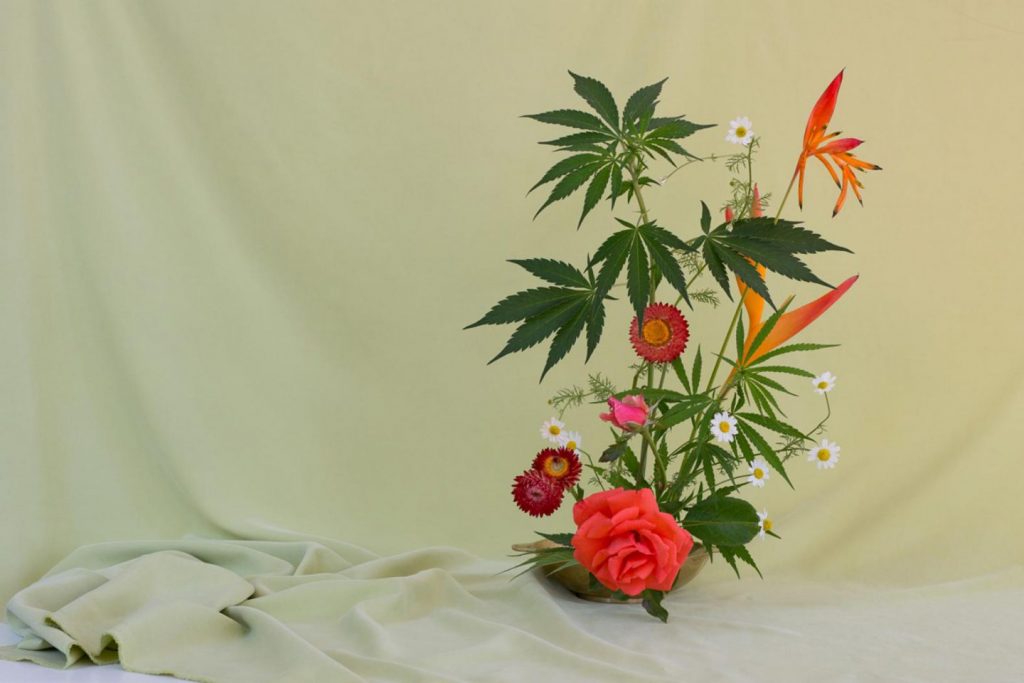Interview: Samantha Miller, Chief Science Officer at hmbldt
How the biochemist and cannabis enthusiast fused two passions

Launched last year, hmbldt is a medical cannabis brand that marries design and data to help consumers make controlled, informed decisions about their usage. Their “dose pen” vibrates when it delivers a precise volume of scientifically crafted vapor. Packaging, (along with the pen and the branding) designed by Anomaly, is crisp, tasteful and accessible. It includes specific information not only about the THC and CBD profiles but also the accessory cannabinoids that make up the formulation. Currently there are four blends which we have tested and wholeheartedly endorse. They’re named for their functions: Bliss, Relief, Calm and Sleep, and for Valentine’s Day they’ve just added two more—Arouse and Passion. Fascinated by the depth of science that has come to historically loose and unpredictable territory, we spoke to one of hmbldt’s founders, and the Chief Science Officer, Samantha Miller to learn more about her work as a biochemist and how she married her corporate scientific background with her cannabian roots.
Tell us a little about your background.
I’m a biochemist. I’ve done a few things in my career. In my academic work, I focused on development of cancer and AIDS drugs. I moved into overseeing EPA laboratories and took a long look at the environmental damage that we’ve done. And I actually moved through the technology world, from the engineering side and then marketing for IDEX Corporation, a company that makes all the enabling technologies for the equipment I use in my laboratory. Then ultimately on the operational side of things and to an operational excellence role, overseeing process improvement optimization and all those things, using Lean and Six Sigma processes.
So I come from a fairly corporate background. But I also have had a relationship with cannabis for my entire—from adolescent to adult—life. I’ve been involved in the growing of cannabis for 25 years, so along with my regular formal corporate career, I’ve had this longstanding relationship with cannabis. In northern CA to a certain extent, you’re born into it.
Wow, I never would’ve expected to hear cannabis and Six Sigma in the same breath. Prior to starting Pure Analytics in 2010, were you wanting to create this kind of business or did you have an “aha!” moment when you realized your relationship with cannabis and your background in biochemistry could join and be your future?
Well, as all great things in life, it was very much serendipity. I wasn’t looking for it—I had a great job, I had a nice corner office, great salary, a great trajectory in my career in terms of climbing the ladder, which is what we’re all trying to do, I guess, in our corporate careers.
I got a phone call from somebody I went to high school with, and they wanted to buy a piece of equipment to do their own cannabis testing. I said to him, “Well, this is what you need to buy, but I’ll say it with the caveat that you need to hire a scientist as well because you need somebody who’s qualified to operate it or you’ll damage it.” Later they called me again and said, “We destroyed it, will you come over and look at it?”
I’ve got all the skills, I don’t have any money, but I’ve got a piece of equipment. I could do this.
There was something about it that got inside my head. I hadn’t even really conceived of the concept of a cannabis lab because there weren’t very many out there to have heard of. I wasn’t engaged in the formal marketplace of cannabis, more in the legacy and culture of cannabis, and so I thought, “I could do this.” I’ve got all the skills, I don’t have any money, but I’ve got a piece of equipment. I could do this.
So I went for it, and I developed a brand— Pure Analytics—and some processes by which we did things, developed methods to do the chemistry. And went out there and started selling it, and it blew me away actually. It was more successful than I expected it to be, so I quit my corporate job and dove in with both feet.

I love that story. What about the taking this next leap—and I’m sure there’ve been many chapters between then and now—but let’s skip ahead to your joining hmbldt.
It was about a year ago that I started working on the hmbldt project… We tested some samples for the project. It was in its nascent stages of product development and deciding what products it was going to offer. The more I fielded their questions and spoke with them about what they were doing, we hit it off—in terms of our business ethics, our ideas about what we could do from a product perspective, what our passions were with respect to cannabis. We had alignment between us in this dialogue around me consulting on their product development.
I think that’s the only way you really achieve sustainable business ventures is through truly organic alignment between people
In the seven years that I worked in the laboratory, I had a lot of opportunities come across my desk—with start-ups and investments—and I said no to every other opportunity because, for me, what’s most is important is alignment in a very organic sense. I think that’s the only way you really achieve sustainable business ventures is through truly organic alignment between people or organizations.
I designed our formulas, both the cannabinoid and our terpene profiles, and the story in that, and the messaging behind hmbldt, the content that you see on the website. That story is the story that was developed out of my seminar series that I’d done for about seven years at Pure Analytics. It’s very rewarding to have the muscle so to speak of hmbldt to reflect that message and accentuate it, and to make it available to so many more people than I could only hope.

So back to the lab for a moment. I understand how you can develop a methodology to look at the unique aspects of each flower, each strain, etc, and develop measurements around that and document it, but what about the side of understanding the impact that THC and CBD and the terpenes have on a patient or customer. What is the methodology behind that?
That’s why we’re looking more at clinical trials. That’s where the human subject comes into play, where you have a controlled study, where you have defined amounts of THC, or CBD or cannabinoids, depending on what it is you’re exploring.
You have placebos, a double-blind study, and you probably have a couple components to it— probably a self-reporting survey component where the people actually talk about and respond to a survey on feedback on their experiences. Did they experience recent pain or whatever it was the study was exploring. And then there’d be clinical measurements where there’d be blood drawn and the metabolic products of THC and CBD, various terpenes could be looked for to see how our body metabolizes them from a time/space perspective to understand how long those remain active in the body. We’re just at the beginning of that work.
At hmbldt we have opportunities to participate in clinical trials, but in the broader cannabis space we’re just entering into—especially in the US—the time where real clinical trials will be happening… That’s really the next step.

Are hmbldt’s formulations based on informal clinical trials or on the deep knowledge from being part of a community that communicated effectively about their experience with different strains and oils?
Designing the formulas draws from a few different sources. One is of course the published literature. Second is my own interaction with patients in the database that I’ve developed over the last several years that provides indications of which cannabinoid ratios are efficacious for given illness or conditions.
We also have an extensive amount of cannabinoid and terpene data associated with patients indicating what a particular strain in the flower form, for example, did for them. Then there’s also consumer testing we did. We couldn’t call it a clinical trial because it wasn’t done in that formal manner, but it was self-reported through an electronic survey, where people tried our various formulas and provided their feedback on how it worked or didn’t work for them.

I get the sense talking that you’re constantly thinking about new formulations, treatments, etc. What’s coming up next that you’re really excited about?
There’s so much that’s exciting… I’m most excited about the next round of CBD-rich formulas that we’re putting out: our Focus, Energy and Control formulas. There’s a lot of demand for CBD products in the cannabis marketplace today and many fall short of consumer expectations and really consumer requirements in terms of content, dosage control and efficacy.
Focus, I think, is a fantastic formula: it’s a 4:1 CBD to THC formula, it’s one of the ones that had the highest ratings in our consumer testing, so I’m really excited about putting it out. Energy and Control also had very high ratings as well. They have very low amounts of THC in them, very different terpene profiles between the two of them, where Energy is, as its names suggests, meant to be energizing for the user. Where as Control is a really fascinating option, and one I think we’ll find most dispensaries will want to have on hand—Control is meant to be an anecdote to excessive THC consumption. It’ll help bring you back from the edge.
Oh?
One of the things that’s great about CBD is it can actually disrupt the feelings of intoxication from THC when you over consume, so we’re excited about the Control formula as a safety net for people who are trying cannabis for the first times to have an option to pull them back if they’ve gone a little too far.
Wow. I had no idea about that side of CBD.
And then we’re also doing an exciting new release of two formulas to help enhance people’s intimacy and sexual experience. The consumer testing is of course, a fantastic adventure.
Yeah, I’m sure you’ve got plenty of people that have volunteered. “You want me to do what and then do what? Okay!”
Yeah, no shortage of volunteers. It’s a popular option.
It was the first time in my professional life that I was able to be a unified human and not this bifurcated human.
I’m in California often and it has been amazing to watch the change in culture, perception and general openness about cannabis. I’m still an East-Coaster at heart and feel like I need to be secretive. It’s a refreshing change.
Yeah, me too, I’m in the same boat. And that’s what opening the laboratory really was for me, it was the first time in my professional life that I was able to be a unified human and not this bifurcated human who couldn’t even talk about what music I listen to. It wasn’t okay to be who I was and be the professional I was.
This [the “Green Rush”] doesn’t feel like a bubble because it’s so grounded in people’s behavior. Silicon Valley was creating new space and new things to care about—widgets and stuff we never had before. This is something that, for people like you and me, has been part of our lives for decades, so its sustainability as a new market is greater. The dynamics of it are even more fascinating.
That’s a really, really good point. I hadn’t put that together yet, so thank you. I like that a lot. It gives me a lot of confidence that there’s a sustainable future for cannabis.
Images courtesy of hmbldt












